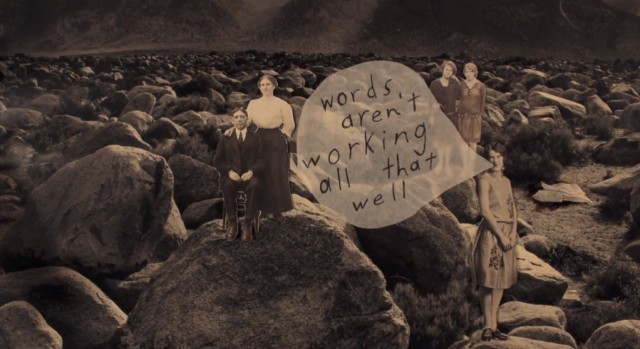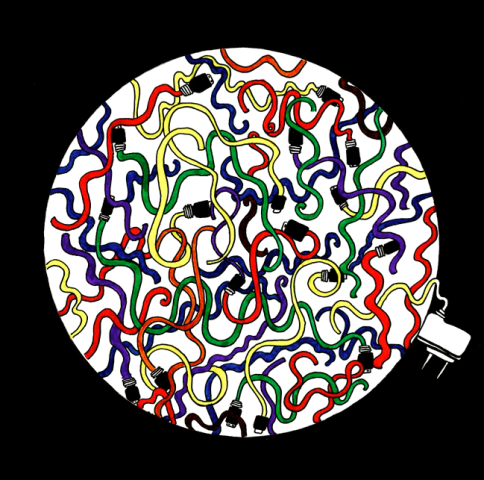While San Francisco prides itself on being one of the most environmentally conscious cities in America, a lot of unnecessary materials still end up in the landfill because we either don’t know how to sort or we fail to see the real value in what we toss. According to Recology San Francisco, the city’s primary resource recovery company (which is also worker-owned), 1,400 tons of landfill-destined waste are collected daily from San Francisco residents in Recology’s well-known green, white, and blue trucks that sport “Sunset Scavengers” on the sides. Additionally, 600 tons of compostable materials (green bin) and 600-700 tons of recyclables (blue bin) are collected daily.
From curbside, the landfill materials from your black bin are then hauled to Recology’s San Francisco Transfer Station, a hub for sorting materials as well as public programs, and then across the Bay Bridge to Livermore. Fortunately, Bay Area artists in Recology’s Artist in Residence Program have an innovative approach to changing our perceptions of waste and limiting what reaches the landfill. Through an artistic revival of what some consider trash, and outreach, Recology is successfully exposing our wasteful habits.
To me, art is feeling, seeing, and exploring. It’s creating something tangible and meaningful out of little to nothing of material value and it’s putting a pen (or brush) where your mouth is, hoping people can learn to listen in a new way. A piece of paper with stains and rips, a half broken piece of ceramic. These are the most inspiring objects because while they may seem to have no further use, with a dash of creativity they hold immense potential. Through art, you can challenge assumptions, make people uncomfortable, or make yourself uncomfortable. I love it! And it will be with me as long as I live. The artists in the program also aim to challenge society’s views or challenge themselves. As the program’s director for the last 8 years, Deborah Munk, puts it: “the artists will either learn to criticize the materials they use, and/or inspire the public to re-think what they throw away.”
Who are these artists that work with trash?
The residency program is one of Recology’s most effective strategies to inspire change in the public’s recycling and re-use habits. Every year, 6 artists are chosen for the program, each commissioned and usually full-time for about 4 months. Artists are free to make what the muse inspires them to, as long as they use the discarded materials available in the Public Disposal Area at the Transfer Station. Instead of ending up in the landfill, much of what gets dropped off is either donated for re-use, recycled, or used by the artists. Munk notes, “When applying, you’re not required to submit a proposal that is focused around an environmental issue. And once accepted, we don’t require you to stick to your proposal either. In fact, it’s interesting to see how each artist will react to the materials available for them at the dump.” If you’re an artist and want to apply for the Artist in Residence Program, Recology takes applications from June 1st to September 1st for the following year. Also, if you’re looking for cheap art materials, you can pick up free paint from the Household Hazardous Waste Facility at the Transfer Station and also check out SCRAP’s list of places to find re-claimed materials around the Bay. SCRAP is a non-profit organization in San Francisco that houses materials for creative re-use and hosts public workshops, similar to Recology.
One of the artists in Recology’s fall 2014 residence, musician and animator Jeremy Rourke, didn’t aim to make an explicit environmental statement but what he created was nonetheless inspirational. In his still pieces and animated videos, Rourke used found paints, photographs, and cut up paper scraps. He has a passion for helping others to see old items through a new light and connecting periods of time. “I especially love to work with materials [like a photograph] that would otherwise disappear to be forgotten…. it’s magic,” said Rourke. He truly makes what he uses come to life.
Another artist in the same group, Shushan Tesfuzigta, has a more directly environmental objective: she constructs furniture by weaving phone chargers, cables, and other electronics cords. Through her art she shows us that e-waste, while abundantly colorful (and spaghetti like), is harmful to the environment and wasteful. These cords are a byproduct of our obsession with the latest technologies. Trading our old gadgets like a phone for the newest version results in more e-waste that is hard to dispose of and often hazardous.
So this is a resource recovery company with studios for professional artists?
Not to mention a sculpture and vegetable garden, and a children’s classroom! You don’t hear that very often. In fact, there is no other company like it in the United States. Recology’s roots date back to 1921, when Italian immigrants “scavenged” around San Francisco, collecting and sorting salvageable items in burlap sacks and piled them high on the backs of horse-drawn carriages. They collected buttons, tossed army uniforms after WWII; whatever that could be re-used or recycled. Later in the century, these “scavengers” consolidated their work into a few companies that eventually merged as Recology. Even today, some of Recology’s employees are 5th generation descendants of the original immigrant “scavengers.”
Munk explained that she is very happy and proud to work at Recology, an employee-owned company, because they value and support programs like her Artist in Residence and public education programs.
Why the focus on education?
Because “too much ends up in the landfill where it could otherwise be re-purposed, re-used, or recycled,” says Munk, and “the public needs to know that anything in your black bin is destined for the landfill and doesn’t get sorted once at the Transfer Station.” This is why educating the public, especially youth, about what goes where and how to use less overall is a priority for Recology.
Landfills are harmful to our environment. Light items such as plastic bags and Styrofoam can blow away for animals to ingest. Organic waste that is supposed to go into the green compost bin—but doesn’t—creates methane (a greenhouse gas with high global warming potential) when it decomposes in the open air of a landfill. The site can become burdensome for local communities as it grows. And it takes polluting transportation such as trucks to get the materials to the landfill from the Transfer Station. Not to mention, “San Francisco’s available landfill space under the existing contract will run out in January 2016,” according to The San Francisco Department of the Environment.
What can I do?
Well for one, learning to sort properly what you use, while seemingly elementary, is vital—and still a lot of people don’t know how to do it. “The more Recology can educate the public to avoid throwing items in the black waste bin and into the blue and green bins the better,” says Munk. Unfortunately, about half of what ends up in the black bin shouldn’t be there, says Recology SF. Munk also hopes that more cities and collection companies will adopt programs similar to Recology San Francisco’s.
If you’re unsure of what goes where, check out this helpful list, courtesy of Recology. Also if you’re interested in hands-on learning while touring the Transfer Station and meeting the artists, Recology, in partnership with the Department of the Environment, gives tours to more than 4,000 school children and adults annually. Get more information about joining a tour here.
Ultimately, we need to change the way we think about consumer products. Questions we should ask ourselves before we make a purchase are, “Do I need this? How long will I keep it, and where will it go when I don’t want it anymore?” It’s never too late to change our habits and to challenge our previous assumptions about something, like the potential of a scrap of paper. And art is a wonderful way to do that. The very essence of creating is bringing to life something that was once nothing, and what can be more magical than that?


